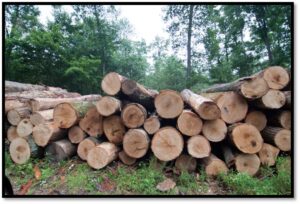Forest Fridays: The Working Forest – Technologist
By: Ryan Reed
You may recall last week’s reference to National Forest Products Week, which is celebrated the third week of October, annually. Today we recognize, while acknowledging their innumerable other values, the benefits of working forests.
The premise of the working forest is not new; the philosophy is rooted in a paradigm supported by the Multiple-Use Sustained-Yield Act of 1960. The act essentially authorizes federal forest managers to administer forests for “multiple uses and sustained yields of products and services.” Oft-recognized products and services include timber, clean water, wildlife habitat, and recreation. In the DCNR Bureau of Forestry, we strive to strike a balance between these uses and values, and sustainable harvesting of timber is an essential part of that equation.
 Seeing a forest tract “at work” can mean different things. The forest is always working to provide habitat and clean water, and mostly does so without human influence. However, producing a steady yield of timber and recreational opportunities like trails requires human work. For some observers, the output of this work can be jarring. I must admit seeing the aftermath of a harvest of mature timber, despite my education and experience, produces mixed feelings. Part of me mourns the loss of the mature trees, some of which could have been key landmarks in prior forest experiences. Perhaps they were part of a viewshed I once admired. The promise of sustained yield thankfully assures that these values are not lost forever. Responsible, sustainable management means these experiences and values will be available again. It just takes time.
Seeing a forest tract “at work” can mean different things. The forest is always working to provide habitat and clean water, and mostly does so without human influence. However, producing a steady yield of timber and recreational opportunities like trails requires human work. For some observers, the output of this work can be jarring. I must admit seeing the aftermath of a harvest of mature timber, despite my education and experience, produces mixed feelings. Part of me mourns the loss of the mature trees, some of which could have been key landmarks in prior forest experiences. Perhaps they were part of a viewshed I once admired. The promise of sustained yield thankfully assures that these values are not lost forever. Responsible, sustainable management means these experiences and values will be available again. It just takes time.
A wider perspective remembers that the wood that was cut didn’t cease to exist, rather, it went to a mill for processing. From there, maybe it went to a cabinet maker who sold it to a finish carpenter, who in turn installed it in someone’s (maybe yours?) kitchen. It’s hard to argue against the beauty of a wood product that came from Penn’s Woods, and how many jobs were supported in the chain of custody in the scenario above? When natural resources are backed by regional economies, they tend to be conserved. This is as true here as it is in Africa where remote hunting economies are the main drivers of large game conservation.

The chestnut sided warbler prefers young forest habitat
Speaking of wildlife conservation, an entire cohort of animals requires young forest that regenerates after timber harvesting. Seriously declining populations of golden winged warblers, a Species of Greatest Conservation Need, and the ruffed grouse (our state bird) both require early successional forest that regenerates after cutting.
The working forest is a forest management model that aspires to responsibly derive the most benefit from our forests, and wood products are a key component. The DCNR Bureau of Forestry will continue to work hard to provide this renewable resource while using the best available science to ensure Pennsylvanians and our forest inhabitants alike, will continue to receive all the benefits of the working forest.
Forest Fridays is a project of the Pennsylvania Department of Conservation and Natural Resources, Bureau of Forestry. Shared courtesy of DCNR and the Author.


